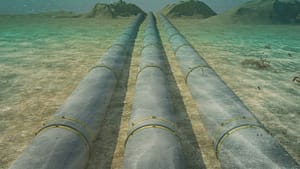

The recent incident involving the cutting of three underwater data cables in the Red Sea has illuminated the fragility of the global communications infrastructure, which is pivotal for internet and telecommunications around the world. This event is part of a larger narrative of geopolitical tension, primarily involving Yemen’s Houthi rebels, who have been engaging in various forms of maritime aggression in the Red Sea region.
The Houthis are an armed political and religious group which champions Yemen’s Shia Muslim minority, the Zaidis. They declare themselves to be part of the Iranian-led “axis of resistance” against Israel, the US and the wider West – along with armed groups such as Hamas and Lebanon’s Hezbollah movement.
The cables affected include significant conduits of global data traffic such as the Asia-Africa-Europe 1, the Europe India Gateway, and the Seacom and TGN-Gulf lines. The disruption caused by these cuts has led telecommunications companies to reroute traffic, highlighting the robustness and redundancy built into the global communications system but also underscoring its vulnerabilities to geopolitical strife and deliberate sabotage.
The strategic importance of the Red Sea for global communications cannot be overstated. It serves as a crucial passage for data moving from Asia to Europe, embodying a digital Silk Road that underpins much of the global economy. The cutting of the cables, affecting approximately 25% of the traffic flowing through this maritime corridor, not only has immediate implications for internet and telecommunications in the region but also raises concerns about the security of global digital infrastructure. This incident serves as a stark reminder of how geopolitical conflicts can extend into the digital domain, affecting global connectivity and information exchange.
The precise motives behind the cutting of the cables remain a matter of speculation. While there have been concerns about the potential targeting of these cables as part of a broader campaign by the Houthi rebels, related to the wider conflict in the region, the Houthis have denied any involvement. The ambiguity surrounding the incident adds to the complexity of the situation, reflecting the opaque nature of modern warfare and the difficulty in attributing responsibility for actions that have widespread repercussions beyond the immediate theater of conflict.
The incident has prompted a response from telecommunications companies and the international community, highlighting the resilience of the global communications system. The built-in redundancy of the network, with multiple cables traversing the Red Sea, has allowed for the rerouting of traffic and mitigation of the impact on global communications. However, this event has also led to calls for increased measures to protect critical undersea infrastructure. The vulnerability of these cables, lying at the bottom of the sea, to sabotage or accidental damage underscores the need for international cooperation in safeguarding them.
Moreover, the incident in the Red Sea is a microcosm of the broader challenges facing the global communications infrastructure. As the world becomes increasingly interconnected, the security of the physical and digital networks that enable this connectivity is of paramount importance. The reliance on a relatively small number of undersea cables for the vast majority of international data traffic is a potential Achilles’ heel, one that could be exploited by state and non-state actors alike.
In light of this, there is a growing recognition of the need for a comprehensive approach to the security of undersea cables. This includes not only physical protection measures but also diplomatic efforts to mitigate the risks of deliberate sabotage as part of geopolitical conflicts. The international community faces the challenge of developing norms and mechanisms for the protection of critical infrastructure that is often located in international waters, beyond the jurisdiction of any single nation.
The cutting of the Red Sea cables is a reminder of the interconnected nature of the modern world, where physical infrastructure in a narrow maritime corridor can have far-reaching implications for global communications and, by extension, the global economy. It highlights the need for vigilance, cooperation, and innovative solutions to protect the underpinnings of our digital world. As we move forward, the resilience of the global communications infrastructure will increasingly depend on our ability to navigate the complex interplay of technology, geopolitics, and international law.

Amcv.ro – Strategii de promovare eficiente – Platforma unde creativitatea si promovarea se intalnesc pentru a da viata afacerilor tale!
Ne-am propus sa oferim o platforma unica si eficienta pentru cei interesati sa-si promoveze afacerile, produsele sau serviciile prin intermediul advertorialelor personalizate si a articolelor de promovare. Suntem aici pentru a va ajuta sa va faceti vocea auzita in lumea online, sa va conectati cu audienta tinta si sa va evidentiati in fata competitorilor.
Indiferent daca aveti o afacere mica sau una mai mare, Amcv.ro este locul potrivit pentru a va face cunoscut mesajul. Cu noi, puteti posta advertoriale personalizate care sa reflecte in mod autentic valorile si misiunea afacerii dumneavoastra. Fie ca sunteti in domeniul comertului, al serviciilor sau al productiei, exista mereu un spatiu pentru dumneavoastra pe Amcv.ro.